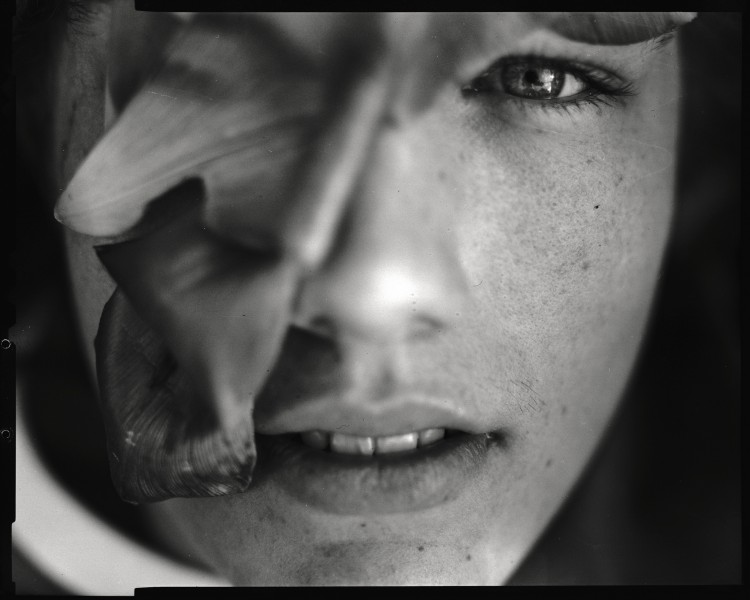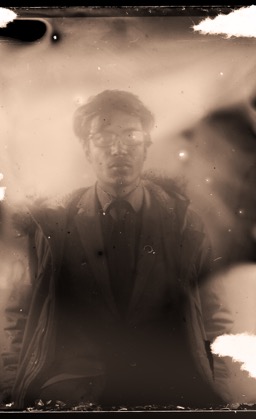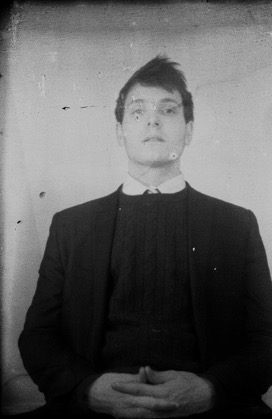Fresh in:
-
 Praktica GP 200 Focus Free £10.00
Praktica GP 200 Focus Free £10.00 -
 Pentax Espio 838G £30.00
Pentax Espio 838G £30.00 -
 Nikon Lite Touch Zoom 70WS AF £30.00
Nikon Lite Touch Zoom 70WS AF £30.00 -
 Minolta AF-E II £35.00
Minolta AF-E II £35.00 -
 Panorama Wide Pie £5.00
Panorama Wide Pie £5.00
-

On our FOCSUED series today is 19 year old William Britten or as a lot of people see him as the look a like to actor Benedict Cumberbatch. We met Will a few months ago on our market stall, for the first time holding his 2.8F Rolleiflex. A few weeks later he came back with his beautiful Crown Graphic casually around his neck! His love and dedication to film photography is phenomenal where his techniques range from using standard medium format black and white film to making his own Albumen prints and glass plates. We managed to sit down with Will to discuss this love affair he has for film photography and at such a young age how he started using all these alternative processes:
Film’s Not Dead: You’ve made such an impression on us, when we first met you at the market, with the beautiful cameras you own and also with the amount of love you have for the medium we were just blown away. What drew you to start photography?
William Britten: I was extremely, extremely fortunate in the sense that I probably went to one of the only schools in the country that has a full darkroom open to me since I was as young as 13. We had 5×4″ enlarger, four medium format enlargers and 35mm ones with full black and white capabilities, I was able to do photography GCSE. From a young age I suppose I was at a very impressionable age, I was instantly keen to do more.
We went out once the start of the first lesson with pinhole cameras made out of beer cans and I was like, ‘I’ve been told what to do, but I don’t really know what I’m doing’. But when we brought it back to the darkroom and put the paper in the chemicals, I remember just freaking out and thinking this is crazy, instantly then I wanted to push the boat out, and asked ‘when can we go out again? Can I go out now to do it again!’
Film’s Not Dead: That was your first reaction to analogue photography, it must have been so exciting.
William Britten: Yes it was, when I went home after school that day I typed in what I’d done, to see what other people had been doing with pinhole cameras and after that I was hooked. I always wanted to try and be ambiguous with it, trying to do something in a different way. I then went on to set up a Solargraph which ended up being 7 months long, using the same beer camera pinhole. After the pinhole lesson we started to go out with 35mm, I used that a little bit. Yet at the time my teacher had his Rolleiflex and he was trailing behind us shooting with that, I was thinking ‘what he’s doing looks far more interesting than what I’m doing’. I only shot two rolls of 35mm film before I spoke to my teacher and said ‘I want one of those, but I haven’t got any money, I’m only 14, what can you offer me?’
I gave him £25, what he gave me a few weeks later was a Del Monta 120 medium format camera. It was very basic, it didn’t have a ‘modern’ frame counter so I had to use the red window in the back, using only HP5 black and white film, I sort of stuck with that in a naive way.
Film’s Not Dead: Why do you say it’s naive, is it because that is the film most schools start you off on?
William Britten: Yeah because of that and I was just sort of going out to the park, I would be learning from my teacher directly where as everyone else would be wondering and not really thinking about what they were doing and I think my teacher recognised that within me at a young age that I was actually thinking about it, medium format help me with that.
With this class there’s only 30 people in the year who get to do it, everyone gets the chance to have a lesson in it then they select people, as it’s a more one to one basis’s, there’s two teachers ones in the darkroom the other is in the studio.
Film’s Not Dead: This school sounds like a dream!
William Britten: Ha ha, it used to be a grammar school now it’s a state school, it’s called Northampton School for Boys.
Film’s Not Dead: So do you prefer studio or location?
William Britten: I’ve always found natural light so much more enjoyable to work with than studio lights. I don’t mind making my subject feel uncomfortable, not totally relaxed, as the longer they wait, the more awkward they get which can achieve some more interesting results. I find the studio is too friendly, it’s a comfortable environment.
I love improvising where you will see on my Instagram I’m using eggs boxes to hold up a light and my subject is lying on the kitchen table with the tripod and camera above them, don’t worry I do make sure it’s safe before putting anyone under it, but it looks precarious. I feel when you do things on the spot it’s unpredictable, a bit like film, the best way to learn is from mistakes and doing the things I do you can make a lot of mistakes.
Film’s Not Dead: Now your 19 your at university, are you still in touch with your teachers from your school?
William Britten: From when I was 15 I was already helping the year below me, I did over 400 hours of volunteer work in my frees or lunch break I stayed in the room and set up a photography club. People could come in I would help them with their sketch books, for me sketch book work I loved doing and still do now, I just collect bits and bobs for my own inspiration.
On the 12th of December I will be going back to my school to help out for a week, one of my teachers managed to salvage a 20×16″ camera and since I’ve been gone he’s been restoring it and making dark slides for it.
Film’s Not Dead: Wow that sounds incredible! Were your teachers your inspiration?
William Britten: Mr Russell Parker and Mrs Ro Mindham, their both massive inspirations to me. Mr Parker is a very interesting person, but I loved how unsupportive he was, he was supportive of what I was doing but he wouldn’t show me praise or hold my hand. He gave me tough love, all the processes I was asking him about he would say yes you can do it but your on your own from now.
Like when I first did 5×4″ I said ‘I need to load film into a dark slide how do I do it?’, he replied with ‘notches are on the top right, go’ he closed the darkroom door and I was in there for half an hour trying to figure it out, he said I couldn’t come out until I was finished. That is how I have learnt, through trial and error, yes it’s crushing when things go wrong but you just have to try again!
For this new camera they have Mr Parker is using 20×16″ photo paper and getting a negative and then printing directly to make a positive. I can’t afford the 25 sheets of 20×16″ so I’m going to try to experiment with 5×4″ negatives by putting them on to a sheet of acetate. These are the up and coming students at the moment (shown below), I even sold my old Rolleicord to one of them, I didn’t make any money on it but I said to him that he really should carry it on.
The great thing about Northampton is we also have a great camera shop there called Skears Photographic and they sell pretty much everything you need from 35mm cameras, medium format, down to small obscure 5×4″ accessories, their really enthusiastic people and an ex Rollei Technican works there too so I’m able to get my Rollei fixed and serviced by him when I’m there.


Film’s Not Dead: What ultimately are you trying to achieve in your photography?
William Britten: My dream has always been, I would like to do photography professionally and I have managed to sell some pieces, but I don’t want that to be my main source of income. I want to be a teacher or a lecturer as I really enjoy teaching people. For example I will encourage my friends to use analogue photography, I love the process of them taking their first photo and working with them to see their progression. I also feel it helps me as a photographer to re-analyse myself, you need to.
I want to preserve these old techniques and by teaching people hopefully they will keep it going.
Film’s Not Dead: We understand you have a real love and passion for alternative processes. Where do you get your inspiration to work with these processes from?
William Britten: For me it wasn’t just a check list like I’m going to do Albumen and now I will try glass plates I did it because it felt natural to me and what I wanted to do. I was very drawn to Eugene Atget’s work I love France, this was two years ago when I thought how can I do this kind of similar work. People do say to me you shouldn’t do what technique they did as your just trying to be like them. I don’t believe that as the method is never neutral and material always matters.
If I captured a scene on my medium format, B&W camera then the same scene on a 5×4″ camera then printed it as an Albumen print, the way it captures the light is so so different, medium format is more pictorial to me, where as albumen is more naturalistic the light is different and so is the texture.
The beginning of trying it was a long process as I couldn’t do it when I wanted, I had to be in the darkroom on my own with it sometimes pitch black in there when putting negs/plates into slides. I didn’t want to expose anyone to my chemicals. Such as when you spill silver nitrate and you turn the light on it turns brown. Now when you go into the darkroom at my old school the whole work bench is covered in it.
The main thing that attracted me was that Atget looked at his pieces as documents and it was the actual craftsmanship that made it a piece of art. Even after Albumen and plates were to an extent out dated, even then he would carry on wheeling them around, carrying really heavy equipment, the whole method is so very much reflected in his work, in the same way people like Vivian Maier, her personality showed through her work. You can see that in Atget’s work, he moved slowly and worked slowly and that time taken is visible in his photographs.
Film’s not Dead: How do you feel when your shooting?
William Britten: I see a little door like something in Charlie and the Chocolate factory appears in my head, it’s not intimidating but then once you the idea is there and get the model/friend ready, you then step into a huge room where things go wrong, but that’s what I love, that thrill of things not going right and maybe that’s why I try things that are difficult. I’m not afraid of failure it’s humbling.
I feel that digital is fast track, the reward is too quick and if you make mistakes you actually learn. The quote from Sally Mann that always says in my mind is “Unless you photograph what you love you’ll never make good art.”
Film’s Not Dead: Why did you decide to go to university?
William Britten: The reason why I choose LCC (London College of Communication) because it was exciting and a challenge. I don’t mind being pushed or being put down. I do appreciate it when people compliment my work but I don’t want to stop now I can always improve. I still feel young in a way as a lot of people say to me I wouldn’t expect a 19 year old to be doing this what a 60 year old man would be doing. People assume that because I’m young I won’t be into the old technique. It’s a good and a bad thing I have to explain what I do, but I enjoy showing people and trying to get people to understand why I do it.
Film’s Not Dead: What advice would you give to aspiring photographers?
William Britten: Personally my view is, you can’t aim to be the next big thing, you just have to do purely do what you love.
Film’s Not Dead: We have to know, but what is your favourite camera to shoot with?
William Britten: My digital camera that I do have gathers dust and probably looks older than most of my other cameras, but it just depends on what I’m shooting. So large format for portraits and then I tend to use mainly medium format if I’m going out, to carry something lighter. It’s just what I feel comfortable with and what I’ve climatized myself to. My favourite thing to do is to make glass plates but that is a real treat for me.
When I shoot I love to shoot within the constraints of that time period like even when I use an electronic light meter I feel bad as some of my biggest inspirations didn’t have these tools we have today!
Film’s Not Dead: Thank you Will for taking the time to do this interview with us is there anything else you would like to say to the readers of Film’s Not Dead?
William Britten: I would say if you have an idea don’t be scared to try it, and photography can be scary for new comers because it’s technical but if you find anyone who has done it before they are videos online and loads of resources and people are happy to help and so am I!
To find out more about Will please click here: William Britten Flickr
Instagram: Yaohen